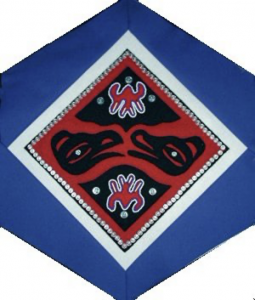Tahtian

The Block
The Tahltan block was created on red stroud, a woven, woollen cloth similar to the blue blankets obtained from trade ships off the coast and used to make traditional button blankets. These blankets are highly valued, particularly when decorated with clan crests. Well-known artists of the Crow clan, Nancy McGhee and her son Shane McGhee cut and appliquéd the flat-form designs of a crow and a wolf head representing the two Tahltan clans. Clan crests have always appeared on ceremonial regalia and other artefacts of daily relevance. Based on a drawing by local carver Edgar Frank, two abstract designs at the top and bottom were created, by Lorraine Henyu. She gave emphasis to the designs by adding beads and quills. A distinguishing feature of these abstract designs is the soft rounded corners. All the elders in the village of Telegraph Creek community participated in making this block by sewing on one of the framing small faux-pearl buttons.
Cultural Profile
The Tahltan are of the Athapaskan linguistic family. Their name means “something heavy in the water” referring to the salmon swimming upstream to their birthplace. Tahltan identity is inextricably linked to the land in the Stikine River drainage basin in northern British Columbia. Since the time of the first ancestors a symbiotic relationship developed between the people and their environment. The land provided the necessary means by which the people lived; food, shelter and medicine. The people in turn protected and respected the land. Closely attuned to their environment, the people knew the land according to the five senses. The lay of the land was understood according to specific landmarks, like a grove of trees or a group of boulders.
The Tahltan Nation is divided into two clans, the Crow and the Wolf. The Crow, or Tsesk’iya Cho, is a sacred bird in Tahltan culture. It is believed that the Creator delegated the handiwork toTsesk’iya Cho, who subsequently features often in legends and stories, providing a model for behaviour. They believe strongly in personal responsibility. Each person has freedom of choice, understanding that to choose the behaviour is to choose the consequences. Young people decided for themselves when they were ready to learn specific skills. Such decisions were made in a social environment that demanded cooperation and contribution from each individual to ensure survival for the whole group.
The Tahltan have long harvested the 25 varieties of berries found in the area and depended upon the plentiful moose and caribou for meat and hides. The people regularly moved within the boundaries of their land to the best area to gather plants or hunt according to the time of year. Tahltan art and clothing design was influenced by West Coast traditions and those of the Dene to the east. Their fur caps and headbands are distinctly Tahltan, though, and the clan crests decorated items from knife cases to ceremonial clothing. A favourite pastime was, and still is, gambling. Gambling games are typically guessing games, of which there were several variations. Special songs are sung during the games, as the players use the rhythm of the drums to enhance their strategy.
Sponsor: Tahltan Band Council
